![]()
![]()
![]()
Use LEFT and RIGHT arrow keys to navigate between flashcards;
Use UP and DOWN arrow keys to flip the card;
H to show hint;
A reads text to speech;
26 Cards in this Set
- Front
- Back
|
Microscopically, acute inflammation is characterized by edema and a prominent infiltration by polymorphonuclear leukocytes (neutrophils). Eosinophils may also be present.
Edema is increased water in cells or the extracellular space. While edema may occur solely as a result of transudation due to increased hydrostatic pressure (as in congestive heart failure) or decreased plasma oncotic pressure (as in many forms of chronic renal disease), acute inflammation also involves changes in permeability of capillary walls with escape of proteins and cells, termed exudation. |
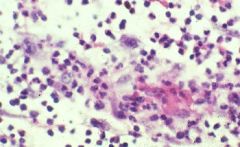
describe and process shown
|
|
|
In contrast, chronic inflammation is characterized by infiltration by mononuclear cells. In this example of non- specific chronic inflammation, lymphocytes are the most prominent, but a few plasma cells and macrophages are also present.
In some forms of chronic inflammation, either plasma cells or macrophages may be predominant. Edema is often usually less evident than in acute inflammation, but fibroblasts are frequently more numerous. |
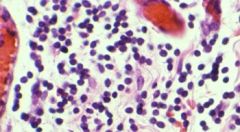
describe slide and process shown
|
|
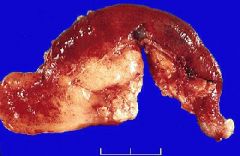
The appendix is swollen and covered with a fibrinous exudate. This is a characteristic appearance of early acute appendicitis.
Compare with the normal appendix, removed incidentally during a gynecologic procedure. |

The inflamed organ above is three times the diameter of this normal one. In constrast to the translucent serosal surface of the normal, the inflamed appendix is opaque and markedly reddened. These changes are much less severe at the base (far right) which is only slightly larger than the corresponding region of the normal.
|
|
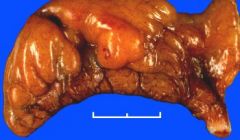
?
|

The engorged vessels on the appendix, removed about 12 hours after onset of symptoms, are the first grossly visible vascular phenomena of the inflammatory process. Compared to the the normal, the organ is also somewhat swollen indicating escape of fluid into the extracellular space, i.e., edema.
|
|
|
An engorged venule corresponds to the vessels on the gross specimen of the appendix. The neutrophils within the vessel are lining up along the wall of the vessel. This process is termed margination, and it precedes the escape of the neutrophils into the adjacent tissue. As the blood vessels dilate and other inflammatory mediators are activated, vascular permeability increases, allowing plasma proteins and leukocytes to pass into the injured areas.
|
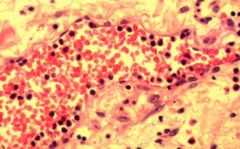
?
|
|
|
The distal appendix, removed about 30 hours after onset of pain, is markedly swollen and covered by a pale yellow exudate (i.e., pus) comprised of fibrin and a large quantity of neutrophils. An exudate comprised predominately of fibrin may appear red, but a large number of white cells result in a purulent exudate with an opaque white or yellow appearance.
|
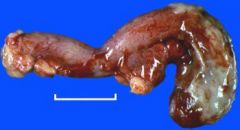
?
|
|
|
Neutrophils pass through the vessel wall and permeate the adjacent tissue. With time, the exudate will become evident on the serosal surface, as shown above. Neutrophils are accompanied by fibrin which is not easy to identify within tissue. Blood within the engorged vessel becomes static and may clot. If the process continues, proteolytic enzymes released by the neutrophils and ischemia due to lack of perfusion may cause the inflamed organ to become necrotic.
|
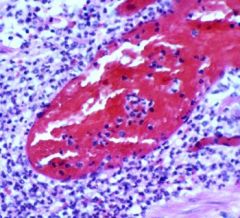
?
|
|
|
Acute fibrinous pericarditis in a patient with uremia due to chronic renal disease. A characteristic red and granular acute inflammatory fibrinous exudate is on the serosal surface. This largely consists of a fibrin-rich fluid although neutrophils are present.
Fibrinogen is an important plasma protein that leaks through the vessel wall. Outside the vessel, fibrinogen is converted to fibrin and polymerizes to produce a relatively insoluble meshwork . The meshwork of fibrin can be appreciated on serous surfaces. |

?
|
|
|
An acute exudate consists of delicate pink strands of fibrin with numerous neutrophils (PMNs).
In the extravascular tissues, neutrophils engulf bacteria and necrotic tissue. After phagocytosis, the white cells degenerate because they cannot renew their lysosomes. Later, macrophages, which are able to regenerate their lysosomes and capable of sustained phagocytosis, arrive to complete the process, and if no tissue destruction has occurred, there may be restoration to a normal state, i. e., resolution. |
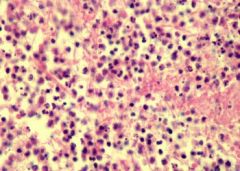
?
|
|
|
Acute bacterial pneumonia with the alveolar spaces filled by an inflammatory exudate including numerous neutrophils . Many different organisms may cause a bacterial pneumonia. Although the outcome was fatal in this example, many forms of acute bacterial pneumonia will completely resolve.
|
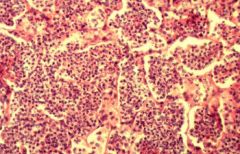
?
|
|
|
In this example of organizing pneumonia, there are prominent spindly fibroblasts along the alveolar walls. Macrophages are now the predominate cell within the alveolar spaces, although a few neutrophils and lymphocytes are also present.
Ultimately, this lung will become scarred and non-compliant if the process is widespread. |
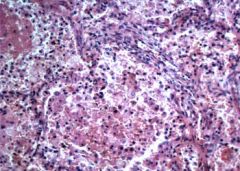
?
|
|
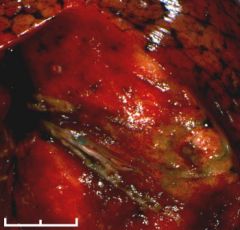
?
|

Greenish-yellow pus exudes from an abscess (at "Arrows"), a localized collection of necrotic tissue debris, fibrin, and inflammatory cells.
Abscesses are most likely to occur with particularly virulent organisms such as Staphylococcus aureus. Bacterial toxins and enzymes released by inflammatory cells lead to tissue destruction. Macrophages cannot effectively clear this walled-off collection of pus, and the patient may remain symptomatic until the abscess is drained or resected. |
|
|
Within the abscess (right), there is destruction of lung tissue and an accumulation of tissue debris, inflammatory cells and fibrin (pus). This process cannot simply resolve, but there may be further localization by organization around the area of tissue destruction.
|

?
|
|
|
Non-specific chronic inflammation in the mesentery around a long-standing inflamed diverticulum of large bowel. It is likely that an initial acute inflammatory response preceded this reaction. Additionally, mixed inflammatory reactions often occur, sometimes termed sub-acute inflammation.
Some chronic inflammatory lesions have more numerous plasma cells, macrophages, or eosinophils. In addition to the inflammatory cellular infiltration, there are prominent new capillaries and fibroblasts. |

?
|
|
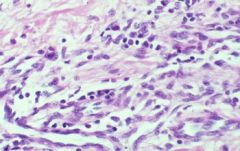
?
|

The inflammatory cellular infiltrate is less prominent, but there are numerous capillaries and fibroblasts and scarring is more evident.
Any ingrowth of new capillaries and fibroblasts is termed granulation tissue, an important stage of wound healing. Granulation tissue is often encountered in inflammatory lesions and, when present, heralds the development of scar tissue. |
|
|
The thyroid follicles are atrophic, but there is a prominent infiltration by lymphocytes which account for the enlargement of the gland. Hashimoto's disease (lymphocytic thyroiditis) is an autoimmune disorder which leads to chronic inflammation and enlargement of the thyroid and is an important cause of hypothyroidism.
|

Over six months, a 39 year old woman had weight gain and slowed speech, and she reported "I just can't think like I used to." Physical examination was normal except for a diffusely enlarged, firm thyroid gland. Following diagnosis of a benign condition by fine needle aspiration, she elected to have a thyroidectomy for cosmetic reasons. A micrograph of the resected gland is shown.
|
|
|
In another region, the marked atrophy of the thyroid follicles is even more apparent, and the dense infiltation by chronic inflammatory cells is greater. A large follicle center is evident (upper right).
The initiating cause of this form of chronic thyroiditis is obscure, but the pathogenesis appears to involve cytotoxic autoantibodies to thyroid microsomes and possibly cell- mediated cytotoxicity of the infiltrating lymphocytes and plasma cells. |
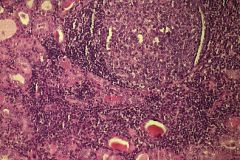
Over six months, a 39 year old woman had weight gain and slowed speech, and she reported "I just can't think like I used to." Physical examination was normal except for a diffusely enlarged, firm thyroid gland. Following diagnosis of a benign condition by fine needle aspiration, she elected to have a thyroidectomy for cosmetic reasons. A micrograph of the resected gland is shown.
|
|
|
There is a chronic inflammatory infiltrate in the portal tract (left) which extends into the liver parenchyma (right) with disruption of the limiting plate. This is an example of chronic viral hepatitis. The infiltrate is primarily composed of lymphocytes with some plasma cells and macrophages.
Chronic hepatitis may result from persistent injury due to viruses, toxic agents such as alcohol, immunological reactions, and other causes. The etiology is usually determined by history or by serologic methods. |

A 40 year old man had fatigue and anorexia for 6 months. Laboratory findings included modestly elevated transam- inases and positive serologic tests for hepatitis B surface antigen. A representative area of a liver biopsy is shown.
|
|

?
|

A high magnification of the portal infiltrate in a patient with autoimmune hepatitis shows the mixture of chronic inflammatory cells that including plasma cells (yellow arrows) and eosinophils (red arrows).
|
|
|
A granuloma is a chronic inflammatory lesion characterized by a focal accumulation of histiocytes. Multinucleated giant cells are often present, as shown in this example of a mesenteric lymph node from a patient with chronic inflammatory bowel disease, but are not an essential component of a granuloma.
Sensitized T-cells, after encountering certain antigens release a lymphokine designated macrophage migration inhibition factor (MIF) that results in local accumulation of macrophages. A similar process occurs when sensitized T-cells encounter foreign material. |

?
|
|
|
Granulomas in the lung in primary pulmonary tuberculosis. The granulomas are surrounded by a cuff of lymphocytes. A few giant cells cells can be seen at this low magnification.
Mycobacteria including the etiologic agent of tuberculosis, fungi including histoplasma, cryptococci, blastomyces, and coccid- ioides, typically evoke a granulomatous reaction. Several other organisms, including bacteria, rickettsia, and parasites can elicit a similar reaction. |

?
|
|
|
The central zone of necrosis in an infectious granuloma is termed caseation. This is a classic feature of tuberculous granulomas. Macrophages and lymphocytes surround the zone of caseation.
|
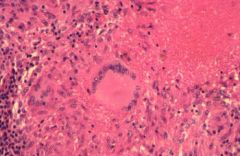
?
|
|
|
An example of granulomatous inflammation in the meninges, caused by the fungus Cryptococcus neoformans. The impressive giant cell (left) contains numerous yeast forms. The giant cell is surrounded by macrophages and lymphocytes.
In some infectious granulomas, the causative organism may be seen in routine sections. However, in most instances, special techniques are needed to identify the etiology. Similar granulomas may occur in non-infectious conditions, such as sarcoidosis and some foreign body reactions. |

?
|
|
|
Foreign body granulomas are a form of chronic inflammation consisting of focal accumulations of macrophages that occur in response to persistent foreign material that is not removed by phagocytosis. In this instance, the etiologic agent is talc. Giant cells containing foreign material are typically present.
|

A 45 year old man had a routine chest x-ray film that showed radiodensities in the lung fields. He worked in a talcum powder factory, was not a smoker, and had no symptoms of infection. A representative area of a lung biopsy is shown
|
|
|
In this foreign body granuloma, talc appears as rhomboid spaces surrounded by macrophages, many of which are multinucleated. Polarized light may facilitate seeing the talc.
|
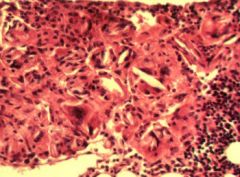
A 45 year old man had a routine chest x-ray film that showed radiodensities in the lung fields. He worked in a talcum powder factory, was not a smoker, and had no symptoms of infection. A representative area of a lung biopsy is shown
|
|
|
The talc particles are birefringent and are more readily demonstrated with polarized light. Many other foreign materials induce granulomas. Surgical sutures are a well-known example.
|

A 45 year old man had a routine chest x-ray film that showed radiodensities in the lung fields. He worked in a talcum powder factory, was not a smoker, and had no symptoms of infection. A representative area of a lung biopsy is shown
|

